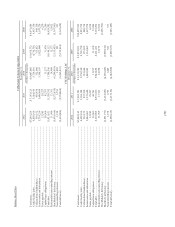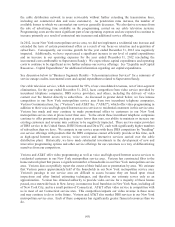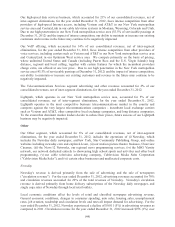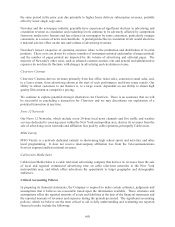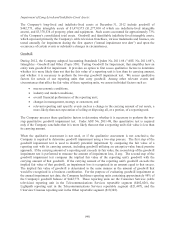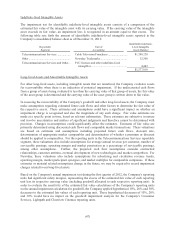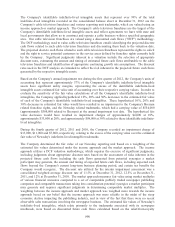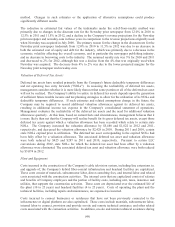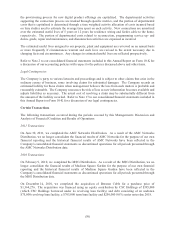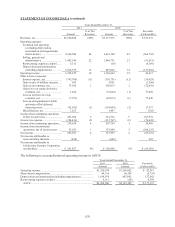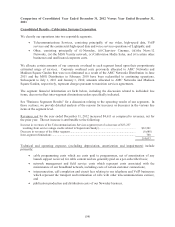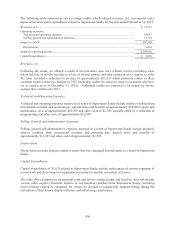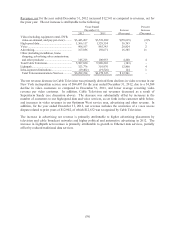Cablevision 2012 Annual Report Download - page 55
Download and view the complete annual report
Please find page 55 of the 2012 Cablevision annual report below. You can navigate through the pages in the report by either clicking on the pages listed below, or by using the keyword search tool below to find specific information within the annual report.(49)
method. Changes in such estimates or the application of alternative assumptions could produce
significantly different results.
The reduction in estimated fair values of the trademarks under the relief-from-royalty method was
primarily due to changes in the discount rate for the Newsday print newspaper from 12.0% in 2010 to
12.5% in 2011 and 11.5% in 2012, and a decline in the Company's revenue projections for the Newsday
print newspaper and newsday.com in those years in comparison to the revenue projections originally used
when Newsday was acquired in July 2008. The primary reason for the change in the discount rate for the
Newsday print newspaper trademark from 12.0% in 2010 to 11.5% in 2012 was due to an decrease in
both the estimated cost of equity and debt for the industry, which was primarily due to a decrease in the
economic volatility affecting the overall economy, and in particular the newspaper publishing industry,
and an decrease in borrowing costs to the industry. The assumed royalty rate was 3% for 2010 and 2011
and decreased to 2% for 2012, although this was a decline from the 4% that was originally used when
Newsday was acquired. The decrease from 4% to 2% was due to the lower projected margins for the
Newsday print newspaper and newsday.com.
Valuation of Deferred Tax Assets:
Deferred tax assets have resulted primarily from the Company's future deductible temporary differences
and net operating loss carry forwards ("NOLs"). In assessing the realizability of deferred tax assets,
management considers whether it is more likely than not that some portion or all of the deferred tax asset
will not be realized. The Company's ability to realize its deferred tax assets depends upon the generation
of sufficient future taxable income and tax planning strategies to allow for the utilization of its NOLs and
deductible temporary differences. If such estimates and related assumptions change in the future, the
Company may be required to record additional valuation allowances against its deferred tax assets,
resulting in additional income tax expense in the Company's consolidated statement of operations.
Management evaluates the realizability of the deferred tax assets and the need for additional valuation
allowances quarterly. At this time, based on current facts and circumstances, management believes that it
is more likely than not that the Company will realize benefit for its gross deferred tax assets, except those
deferred tax assets against which a valuation allowance has been recorded which relate to certain state
NOLs. The Company increased the valuation allowance by $5,480 and $1,822 in 2012 and 2011,
respectively, and decreased the valuation allowance by $2,428 in 2010. During 2011 and 2010, certain
state NOLs expired prior to utilization. The deferred tax asset corresponding to the expired NOLs had
been fully offset by a valuation allowance. The associated deferred tax asset and valuation allowance
were both reduced by $425 and $287 in 2011 and 2010, respectively. Pursuant to certain LLC
conversions during 2012, state NOLs for which the deferred tax asset had been offset by a valuation
allowance were eliminated. The associated deferred tax asset and valuation allowance were both reduced
by $3,074 in 2012.
Plant and Equipment:
Costs incurred in the construction of the Company's cable television system, including line extensions to,
and upgrade of, the Company's hybrid fiber-coaxial infrastructure and headend facilities are capitalized.
These costs consist of materials, subcontractor labor, direct consulting fees, and internal labor and related
costs associated with the construction activities. The internal costs that are capitalized consist of salaries
and benefits of Company employees and the portion of facility costs, including rent, taxes, insurance and
utilities, that supports the construction activities. These costs are depreciated over the estimated life of
the plant (10 to 25 years) and headend facilities (4 to 25 years). Costs of operating the plant and the
technical facilities, including repairs and maintenance, are expensed as incurred.
Costs incurred to connect businesses or residences that have not been previously connected to the
infrastructure or digital platform are also capitalized. These costs include materials, subcontractor labor,
internal labor to connect, provision and provide on-site and remote technical assistance and other related
costs associated with the connection activities. In addition, on-site and remote technical assistance during


